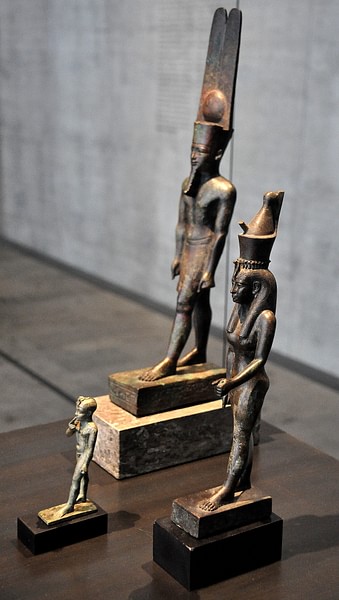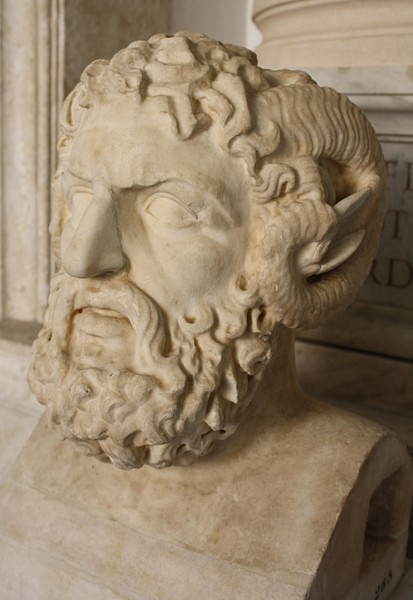Humans long to look to a deity or god believing in the limited scope of their mortality. In exchange for protection, fertility, bountiful harvest, wealth or for slaying foes, they offer sacrifices and worship to such a deity. In ancient Egypt, more than 1,000 different gods and goddesses were worshiped, but one seems to have had an enduring quality.
The god Amun also known as Amon, Ammon and Amen is a powerful ancient Egyptian deity from the Old Kingdom together with his consort Amaunet. With the 11th dynasty (c. 21st century BC), Amun rose to the position of patron deity of Thebes by replacing Montu; the war god.
After the rebellion of Thebes against the Hyksos and with the rule of Ahmose I (16th century BC), Amun acquired national importance, expressed in his fusion with the Sun god, Ra, as Amun-Ra or Amun-Re. He is also regarded as Egyptian god of the sun and air.
Amun-Ra retained chief importance in the Egyptian pantheon throughout the New Kingdom (c. 1570-1069 BCE) till Akhenaten elevated the god Aten to become the empire god.
Amun or Amen was the champion of the poor or troubled and central personal piety. His position as King of Gods developed to the point of virtual monotheism where other gods became manifestations of him. With Osiris, Amun-Ra is the most widely recorded of the Egyptian gods.
As the chief deity of the Egyptian Empire, Amun-Ra also came to be worshiped outside Egypt in Libya, Nubia, Greece and Rome. As Zeus Ammon, he came to be identified with Zeus in Greece.
He is usually depicted as a bearded man wearing a headdress with a double plume or, after the New Kingdom, as a ram-headed man or simply a ram, symbolizing fertility in his role as Amun-Min. His name means “the hidden one,” “invisible,” “mysterious of form,” and unlike most other Egyptian gods, he was considered Lord of All who encompassed every aspect of creation.
Amun was part of the Ogdoad, eight gods who represented the primordial elements of creation.
When Pharaoh Ahmose defeated the Hyksos who had captured Lower Egypt, he attributed his victory to Amun linking him to the well-known sun god Ra. Amun was “The Hidden One” linked to no definable natural phenomenon or principle, he was malleable enough to fit with any attribute one wished to add to him. Soon enough, he became Amun-Ra, creator of the universe and King of the Gods.

ancient.eu
He was part of the Theban triad of deities with his consort Mut (who replaced Amaunet) and their son Khonsu, the moon god.
Egyptologist Geraldine Pinch writes: “In his chief cult temple at Karnak in Thebes, Amun, Lord of the Thrones of the Two Lands, ruled as a divine pharaoh. Unlike other important deities, Amun does not seem to have been thought of as living in some distant celestial realm. His presence was everywhere, unseen but felt like the wind. His oracles communicated the divine will to humanity. Amun was said to come swiftly to help Egyptian kings on the battle field or to aid the poor and friendless. When he was manifest in his cult statues, Amun periodically visited the necropolis of Thebes to unite with its goddess, Hathor, and bring new life to the dead.”
Amun’s influence was so profound as Wilkinson notes, “the monuments which were built to him at that time were little short of astounding and Amun was worshipped in many temples throughout Egypt”. The main Temple of Amun at Karnak is still the largest religious structure ever built and was connected to the Southern Sanctuary of the Luxor Temple.
After the reign of Horemheb, Amun’s cult continued and was just as popular. When the Ramessid Period (c. 1186-1077 BCE) came, the priests of Amun were so powerful they were able to rule Upper Egypt from Thebes as pharaohs. The power of the priests of Amun is said to have led to the fall of the New Kingdom.
According to Wilkinson, “the Kushite kings of the 25th dynasty continued this practice and their rule actually led to a resurgence in the worship of Amun as the Nubians had accepted the god as their own”
“Queen Hatshepsut (1479-1458 BCE) had once claimed Amun was her father and thereby legitimized her reign. Alexander the Great would do the same in 331 BCE at the Siwa Oasis, proclaiming himself a son of the god Zeus-Ammon, the Greek version of the god. In Greece, Zeus-Ammon was depicted as the full-bearded Zeus with the ram’s horns of Amun and associated with power and virility through imagery including the bull and the ram. The god was taken to Rome as Jupiter-Ammon where he was venerated for the same reasons as elsewhere.”

The priests of Amun were so powerful, wealthy and popular also in Sudan (Nubia, Meroe), which also produced kings to sustain the Egyptian empire that King Ergamenes of Meroe had the priests of Amun in his country massacred c. 285 BCE further breaking ties with Egypt and establishing an autonomous state.
As Isis became more popular in Egypt, Amun’s worship declined but despite the massacre of its priests, Amun continued to be revered in Meroe and elsewhere, well into the classical antiquity (c. 5th century CE) till new religion, Christianity eclipsed it.










